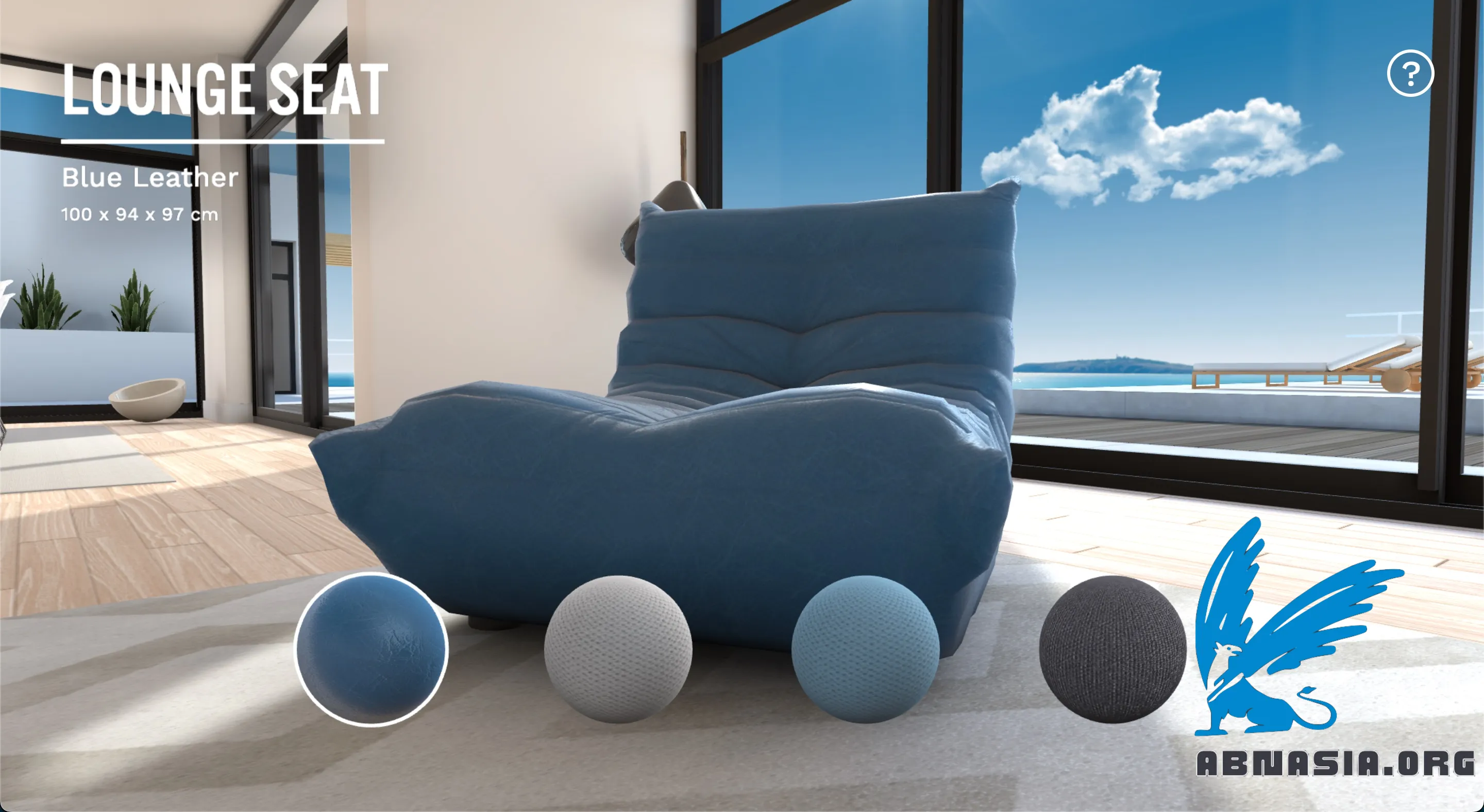
Virtual 3D Showroom
WHAT PROBLEMS DOES IT FIX?
Limited Customer Engagement: Without a virtual 3D showroom, businesses may struggle to capture customers' attention and provide an immersive experience, leading to limited engagement and potential loss of sales.
Inadequate Product Representation: Traditional product displays may not accurately represent products, potentially leading to customer dissatisfaction and returns, whereas a virtual 3D showroom offers lifelike product displays.
Difficulty in Showcasing Complex Products: Complex products may be challenging to showcase in a traditional setting, but a virtual 3D showroom allows customers to explore and interact with these products in a more comprehensive manner.
Insufficient Brand Differentiation: A virtual 3D showroom creates a unique and captivating environment that sets businesses apart from their competitors and modernizes their brand.
Lengthy Sales Cycles: Without a virtual 3D showroom, customers may require more time to make purchasing decisions, leading to longer sales cycles and potential loss of business.
Higher Returns and Refunds: Inaccurate product representations or inadequate product information may lead to higher returns and refunds, which can be mitigated with a virtual 3D showroom.
Inability to Reach Global Audiences: A virtual 3D showroom allows businesses to reach a global audience, as customers can access the showroom from any device with an internet connection.
Dependence on Physical Locations: Businesses without a virtual 3D showroom may be limited to their physical locations, restricting their ability to reach customers beyond their geographical area.
Higher Marketing Costs: Traditional marketing methods may be more expensive and less effective than a virtual 3D showroom in capturing customers' attention and driving sales.
Limited Customer Insights: A virtual 3D showroom provides valuable customer insights, such as interaction data and behavior patterns, which can inform product development and marketing strategies.
Inadequate Customer Support: A virtual 3D showroom can offer self-service options and interactive product demonstrations, reducing the need for manual customer support and improving overall customer satisfaction.
Difficulty in Launching New Products: A virtual 3D showroom enables businesses to launch new products quickly and efficiently, allowing customers to explore and interact with the products in a immersive environment.
Inability to Adapt to Changing Market Trends: A virtual 3D showroom allows businesses to respond to changing market trends and customer preferences in real-time, ensuring they remain competitive and relevant.
Higher Operational Costs: Maintaining physical locations and traditional product displays can be costly and inefficient, whereas a virtual 3D showroom can reduce operational costs and improve resource allocation.
Environmental Impact: The virtual nature of a 3D showroom reduces the environmental impact associated with physical locations, product transportation, and packaging materials.
Limited Accessibility: A virtual 3D showroom can be accessed from any device with an internet connection, ensuring that customers with disabilities or remote locations can engage with the business.
Inability to Leverage Data and Analytics: A virtual 3D showroom provides valuable data and analytics on customer interactions and behavior patterns, which can inform business decisions and improve marketing strategies.
Dependence on Seasonal Sales: A virtual 3D showroom can help businesses reduce their dependence on seasonal sales by providing a consistent and immersive shopping experience throughout the year.
Limited Cross-Selling and Upselling Opportunities: A virtual 3D showroom can offer personalized product recommendations and interactive demonstrations, increasing the opportunities for cross-selling and upselling.
Inadequate Training and Education: A virtual 3D showroom can provide interactive training and education materials for customers, improving their understanding and appreciation of the products.
Difficulty in Building Brand Loyalty: A virtual 3D showroom can help businesses build strong relationships with their customers by providing a unique and immersive experience that fosters brand loyalty and advocacy.
Inability to Compete with E-commerce Giants: A virtual 3D showroom can help small and medium-sized businesses compete with e-commerce giants by providing a comparable and engaging shopping experience.
Higher Customer Acquisition Costs: A virtual 3D showroom can help businesses reduce customer acquisition costs by providing a captivating and immersive experience that attracts and retains customers.
Inadequate Protection of Intellectual Property: A virtual 3D showroom can provide an additional layer of protection for intellectual property by restricting access to sensitive product information and designs.
Difficulty in Managing Inventory and Logistics: A virtual 3D showroom can help businesses better manage their inventory and logistics by providing real-time data and analytics on customer interactions and product demand.
Inability to Leverage Social Media and Influencer Marketing: A virtual 3D showroom can be integrated with social media and influencer marketing campaigns, allowing businesses to reach a wider audience and increase brand awareness.
Limited Customer Personalization: A virtual 3D showroom can offer personalized product recommendations and interactive demonstrations based on individual customer preferences and behavior patterns.
Inadequate Crisis Management and Recovery: A virtual 3D showroom can provide a business continuity plan during times of crisis, ensuring that customers can still engage with the business and access products and services.
Dependence on Traditional Sales Channels: A virtual 3D showroom can help businesses diversify their sales channels and reduce their dependence on traditional sales methods.
Inability to Compete with Direct-to-Consumer Brands: A virtual 3D showroom can help businesses compete with direct-to-consumer brands by providing a comparable and engaging shopping experience that builds brand loyalty and advocacy.
Higher IT and Technical Costs: A virtual 3D showroom can help businesses reduce their IT and technical costs by providing a scalable and cloud-based solution that eliminates the need for expensive hardware and software updates.
Inadequate Support for Omnichannel Retailing: A virtual 3D showroom can support omnichannel retailing by providing a consistent and immersive experience across different sales channels and devices.
Virtual 3D Showroom
$0 per system per month
The 3D Virtual Showroom transforms the way you showcase your products, offering an immersive, interactive experience that allows customers to explore and engage with your items from any device. With stunning 3D visuals and lifelike product displays, buyers can navigate your showroom as if they were there in person, enhancing their shopping experience and increasing sales. Perfect for businesses looking to stand out, the virtual showroom creates a captivating environment that boosts customer engagement, streamlines decision-making, and modernizes your brand. Bring your products to life and make a lasting impression with this cutting-edge solution.
WHAT PROBLEMS DOES IT FIX?
Limited Customer Engagement: Without a virtual 3D showroom, businesses may struggle to capture customers' attention and provide an immersive experience, leading to limited engagement and potential loss of sales.
Inadequate Product Representation: Traditional product displays may not accurately represent products, potentially leading to customer dissatisfaction and returns, whereas a virtual 3D showroom offers lifelike product displays.
Difficulty in Showcasing Complex Products: Complex products may be challenging to showcase in a traditional setting, but a virtual 3D showroom allows customers to explore and interact with these products in a more comprehensive manner.
Insufficient Brand Differentiation: A virtual 3D showroom creates a unique and captivating environment that sets businesses apart from their competitors and modernizes their brand.
Lengthy Sales Cycles: Without a virtual 3D showroom, customers may require more time to make purchasing decisions, leading to longer sales cycles and potential loss of business.
Higher Returns and Refunds: Inaccurate product representations or inadequate product information may lead to higher returns and refunds, which can be mitigated with a virtual 3D showroom.
Inability to Reach Global Audiences: A virtual 3D showroom allows businesses to reach a global audience, as customers can access the showroom from any device with an internet connection.
Dependence on Physical Locations: Businesses without a virtual 3D showroom may be limited to their physical locations, restricting their ability to reach customers beyond their geographical area.
Higher Marketing Costs: Traditional marketing methods may be more expensive and less effective than a virtual 3D showroom in capturing customers' attention and driving sales.
Limited Customer Insights: A virtual 3D showroom provides valuable customer insights, such as interaction data and behavior patterns, which can inform product development and marketing strategies.
Inadequate Customer Support: A virtual 3D showroom can offer self-service options and interactive product demonstrations, reducing the need for manual customer support and improving overall customer satisfaction.
Difficulty in Launching New Products: A virtual 3D showroom enables businesses to launch new products quickly and efficiently, allowing customers to explore and interact with the products in a immersive environment.
Inability to Adapt to Changing Market Trends: A virtual 3D showroom allows businesses to respond to changing market trends and customer preferences in real-time, ensuring they remain competitive and relevant.
Higher Operational Costs: Maintaining physical locations and traditional product displays can be costly and inefficient, whereas a virtual 3D showroom can reduce operational costs and improve resource allocation.
Environmental Impact: The virtual nature of a 3D showroom reduces the environmental impact associated with physical locations, product transportation, and packaging materials.
Limited Accessibility: A virtual 3D showroom can be accessed from any device with an internet connection, ensuring that customers with disabilities or remote locations can engage with the business.
Inability to Leverage Data and Analytics: A virtual 3D showroom provides valuable data and analytics on customer interactions and behavior patterns, which can inform business decisions and improve marketing strategies.
Dependence on Seasonal Sales: A virtual 3D showroom can help businesses reduce their dependence on seasonal sales by providing a consistent and immersive shopping experience throughout the year.
Limited Cross-Selling and Upselling Opportunities: A virtual 3D showroom can offer personalized product recommendations and interactive demonstrations, increasing the opportunities for cross-selling and upselling.
Inadequate Training and Education: A virtual 3D showroom can provide interactive training and education materials for customers, improving their understanding and appreciation of the products.
Difficulty in Building Brand Loyalty: A virtual 3D showroom can help businesses build strong relationships with their customers by providing a unique and immersive experience that fosters brand loyalty and advocacy.
Inability to Compete with E-commerce Giants: A virtual 3D showroom can help small and medium-sized businesses compete with e-commerce giants by providing a comparable and engaging shopping experience.
Higher Customer Acquisition Costs: A virtual 3D showroom can help businesses reduce customer acquisition costs by providing a captivating and immersive experience that attracts and retains customers.
Inadequate Protection of Intellectual Property: A virtual 3D showroom can provide an additional layer of protection for intellectual property by restricting access to sensitive product information and designs.
Difficulty in Managing Inventory and Logistics: A virtual 3D showroom can help businesses better manage their inventory and logistics by providing real-time data and analytics on customer interactions and product demand.
Inability to Leverage Social Media and Influencer Marketing: A virtual 3D showroom can be integrated with social media and influencer marketing campaigns, allowing businesses to reach a wider audience and increase brand awareness.
Limited Customer Personalization: A virtual 3D showroom can offer personalized product recommendations and interactive demonstrations based on individual customer preferences and behavior patterns.
Inadequate Crisis Management and Recovery: A virtual 3D showroom can provide a business continuity plan during times of crisis, ensuring that customers can still engage with the business and access products and services.
Dependence on Traditional Sales Channels: A virtual 3D showroom can help businesses diversify their sales channels and reduce their dependence on traditional sales methods.
Inability to Compete with Direct-to-Consumer Brands: A virtual 3D showroom can help businesses compete with direct-to-consumer brands by providing a comparable and engaging shopping experience that builds brand loyalty and advocacy.
Higher IT and Technical Costs: A virtual 3D showroom can help businesses reduce their IT and technical costs by providing a scalable and cloud-based solution that eliminates the need for expensive hardware and software updates.
Inadequate Support for Omnichannel Retailing: A virtual 3D showroom can support omnichannel retailing by providing a consistent and immersive experience across different sales channels and devices.
KEY BENEFITS
Immersive Shopping Experience: Transform the way you showcase your products with an immersive interactive experience
Increased Sales: Enhance the shopping experience and increase sales with stunning 3D visuals and lifelike product displays
Cost-Effective Marketing: Allow customers to explore and engage with your items from any device, reducing the need for physical showrooms
Captivating Environment: Create a captivating environment that boosts customer engagement with stunning 3D visuals
Streamlined Decision-Making: Enable customers to easily navigate your showroom and make informed purchasing decisions
Enhanced Customer Engagement: Engage customers with interactive experiences and lifelike product displays
Modernized Brand Image: Modernize your brand with a cutting-edge virtual 3D showroom solution
Competitive Advantage: Stand out from competitors with a unique and innovative way of showcasing products
Virtual Accessibility: Make your products accessible to customers from anywhere in the world, at any time
KEY FEATURES
Immersive Experience: An immersive experience that allows customers to explore and engage with products from any device.
Interactive Exploration: Allows customers to navigate the showroom as if they were there in person.
Stunning 3D Visuals: Showcases products with stunning 3D visuals and lifelike product displays.
Enhanced Shopping Experience: Enhances the shopping experience and increases sales for businesses.
Captivating Environment: Creates a captivating environment that boosts customer engagement for businesses.
Streamlined Decision-Making: Streamlines decision-making for customers to make purchases more efficiently.
Modernized Brand: Modernizes the brand image of businesses that implement the virtual showroom.
Cross-Device Compatibility: Allows customers to explore products from any device with an internet connection.
Increased Customer Engagement: Increases customer engagement and interaction with products in the showroom.
Competitive Advantage: Gives businesses a competitive advantage by offering an innovative and unique shopping experience.
WHO USES THE PRODUCT
Home Decor Enthusiasts: Home decor enthusiasts can use virtual 3D showrooms to browse and explore furniture and design products in a realistic and immersive environment, allowing them to visualize how items would look in their own spaces.
Architecture and Design Firms: Architecture and design firms can use virtual 3D showrooms to showcase their designs and products to clients, facilitating better communication, collaboration, and decision-making during the design process.
E-commerce Retailers: E-commerce retailers can use virtual 3D showrooms to enhance their online shopping experience, reduce returns, and increase conversions by providing customers with a more detailed and interactive product experience.
Furniture Buyers: Furniture buyers can use virtual 3D showrooms to explore and compare different furniture products, check dimensions, and visualize how items would fit in their own spaces before making a purchase.
Event Planners: Event planners can use virtual 3D showrooms to visualize and plan event layouts, including furniture, decor, and other elements, to ensure a seamless and successful event execution.
Real Estate Agents: Real estate agents can use virtual 3D showrooms to showcase properties and provide prospective buyers with an immersive and interactive experience, allowing them to explore and interact with virtual property models.
Product Designers: Product designers can use virtual 3D showrooms to test and showcase their designs, gather feedback, and refine their products before going to market.
Interior Design Students: Interior design students can use virtual 3D showrooms to practice and hone their design skills, experiment with different layouts and designs, and showcase their work to professors and peers.
Trade Show Exhibitors: Trade show exhibitors can use virtual 3D showrooms to create virtual exhibits, reduce costs, and extend their reach to a wider audience, allowing them to engage with attendees remotely.
Homebuilders and Contractors: Homebuilders and contractors can use virtual 3D showrooms to showcase their designs and products to clients, facilitate better communication, and streamline the decision-making process during the building or renovation process.











